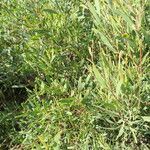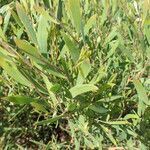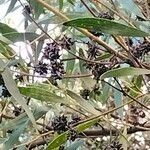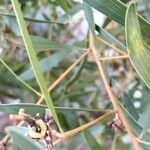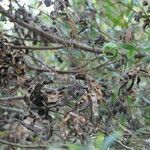Unarmed shrub or small tree up to 6 m high; young branchlets usually angular and glabrous. Leaves phyllodic, apparently simple, glabrous, 3-9 x 0.6-1.5 cm, narrowly-oblong, usually ± straight, sometimes slightly falcate, obliquely mucronate apically, narrowed basally, with 3-5 prominent longitudinal nerves and anastomosing almost longitudinal veins. Inflorescences globose, solitary or two or three in short axillary racemes. Flowers bright yellow; peduncles up to 7 mm long. Calyx pubescent apically, more than half as long as the corolla. Petals free. Pods brown, 5-15 x 0.8-1.3 cm, oblong, falcate or variously coiled or spirally twisted, flattened, margins not constricted between the seeds, dehiscing longitudinally along both margins. Seeds dark brown, 5-7 x 3-4 mm, smooth, compressed; areole ±4x2 mm; funicle thickened, bright red or orange, encircling the seed in a double fold.
A shrub or tree. It is up to 3 m high. It has a rounded crown. The leaf-like phyllodes are thick and leathery. These flattened leaf stalks are 4-9 cm long. The flower heads are round and yellow. They are 4-7 mm across. They are arranged in groups of 2-3. Each head is made up of several tiny flowers each with 5 lobes. The fruit are pods which are greyish-brown. They are 4-12 cm long. They are thick and leathery. They twist as they dry and open up. This reveals black seeds around red, folded seed stalks. These look like a blood shot eye.
Small tree or shrub, 1.5-6.0 m high. Branches angular, glabrous when young. Leaves phyllodia, apparently simple, green, glabrous, narrowly oblong, straight, 30-90 x 6-15 mm, 3-5 prominent veins, apex obliquely mucronate. Flowers globular heads solitary or, 2 or 3 in short axillary racemes, bright yellow. Flowering time Oct.-Feb. Pod brown, 50-150 x 8-13 mm, curved and twisted, flattened, apex acute, dehiscent; seed funicle thickened, bright red.
Rounded shrub or small tree, 2-4(-6) m tall. Phyllodes narrowly oblong, ± straight, obliquely mucronate, with 3-7 longitudinal veins. Flowers in scattered globose heads on short peduncles, yellow. Pod often in coiled clusters, oblong, undulate or twisted, compressed, leathery. Seed black, with a prominent, fleshy, red aril. Mainly Oct.-May.
Shrub or tree to 4 m. Phyllodes oblong, with 3-7, longitudinal veins, bright green. Flowers in globose heads, bright yellow. Pods flat, undulate or twisted, not constricted between seeds. Seeds black, with prominent, fleshy, red aril.
Unarmed shrub or tree, up to 6 m high. Phyllodes 6-25 mm wide, usually straight, sometimes falcate with anastomosing longitudinal venation between main longitudinal nerves. Flowers bright yellow.
